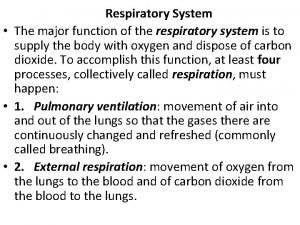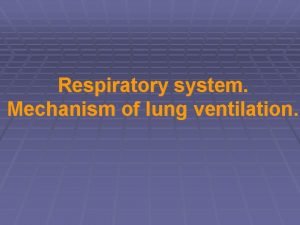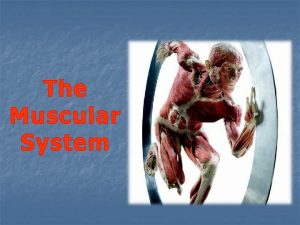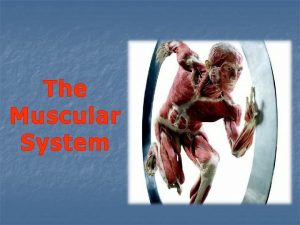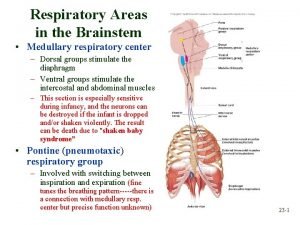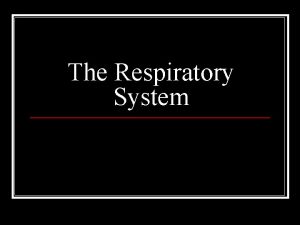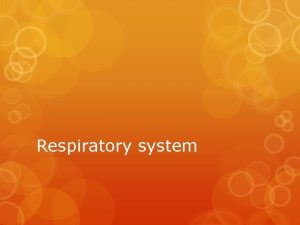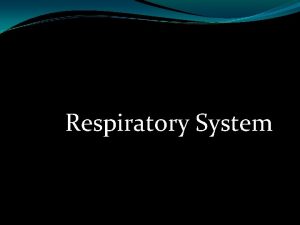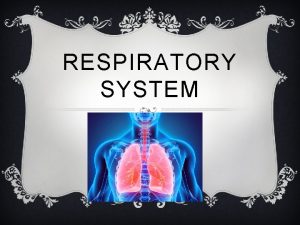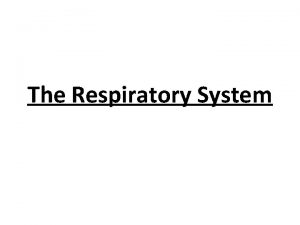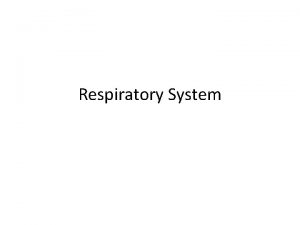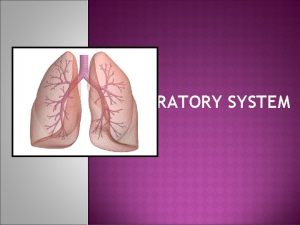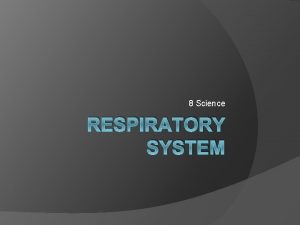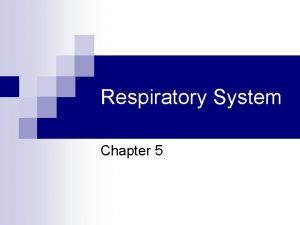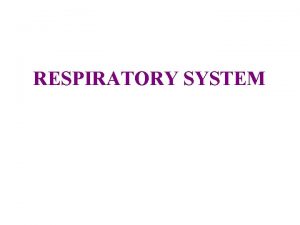Respiratory System Respiratory system n The primary function

































- Slides: 33

Respiratory System

Respiratory system n The primary function of respiratory system is to obtain O 2 for use by the body’s cell and to eliminate CO 2 the cells produced

Respiratory system

Respiratory system n Non-Respiratory Functions of Respiratory system: n Route for heat and water loss from the body n Enhancement of venous return to the heart Participates in acid base balance (through excreting CO 2 which reduce acidity) n The nose acts as organ of smell n A major role in the process of vocalization n

Respiratory system Major Part of Respirator y System

Respiratory system n Alveoli : n place where gas exchange occurs n 300 million alveoli in both lungs n Total surface area ~ 75 m² n Are surrounded by dense network of capillaries n contain two types of cells a) alveolar cell type I b)alveolar cell type II secrete surfactant

Respiratory System n Functionally the respiratory system consist of 2 portions: n n Conducting portion: [ nose, Pharynx, Larynx, Trachea, Bronchi, bronchioles and terminal bronchioles] filter, warm and moisten air and conduct it into the lungs Respiratory portion: where gas exchange occurs [ alveoli] {functional unit of respiratory system}

Respiratory system Pleural Cavity

Mechanics of Respiration n Respiratory movements (Inspiration & Expiration) are achieved by making pressure gradient between atmosphere and alveolar sacs § Air always moves from a high pressure area to a low pressure area § During inspiration air moves from atmosphere into the lungs During expiration air moves of the lungs to atmosphere §

Mechanics of Respiration Three important pressure are considered in respiration :

Mechanics of Respiration Intra-alveolar pressure can be changed by altering the volume of the lungs

Mechanics of Respiration

Mechanics of Respiration During quite inspiration: Inspiratory muscle contract →increasing thoracic volume →decreasing intra-pleural pressure →decreasing intraalveolar pressure (become less than atmospheric pressure (-1 mm. Hg)→ forcing air to move into the lungs (inspiration) Quite inspiration is an active process (need muscle contraction

Mechanics of Respiration

Mechanics of Respiration During quite expiration: Inspiratory muscle relax→ decreasing thoracic volume → increasing intra-pleural pressure → increasing intraalveolar pressure (become more than atmospheric pressure (+1 mm. Hg)→ forcing air to move out the lungs (expiration) § § Quite expiration is passive process ( doesn't need muscle contraction) Forceful expiration is an active process

Respiratory Muscles Respiratory muscles two sets of muscles: n Inspiratory muscles n Expiratory muscles n

Respiratory Muscles n Inspiratory muscles: The diaphragm n The external intercostals muscles n

Respiratory Muscles n The diaphragm: n Main inspiratory muscle n Seperates thoracic cavity from abdominal cavity n Skeletal muscle, supplied by phrenic nerve n During inspiration: It contracts and descends downward increasing the vertical dimension of the thorax, also it increases the anterposterior diameter of the thorax n During expiration, it relaxes and moves upward decreasing thoracic volume

Respiratory Muscles n The External intercostals Muscles: n n n composed of fibers that run downward & forward between adjacent ribs Their contraction elevates the sternum increasing the anteroposterior and lateral dimensions of the thorax (the thoracic volume is increased) This enlarges the thoracic cavity in two dimensions: the lateral & the antero-posterior dimensions

Respiratory Muscles n Accessory inspiratory muscles: n n n Deeper inspiration can be accomplished by: n n Sternocleidomastoid scalenus Forceful contraction of both diaphragm & external intercostals Assistance by the accessory inspiratory muscles, which lie in the neck Contraction of accessory muscles raises the sternum & elevates the first two ribs, thus enlarging the upper portion of the thoracic cavity This extra enlargement will be followed by a greater expansion of the lungs, & a further dropping in intra-alveolar pressure accordingly

Respiratory Muscles n Expiratory muscles: n n Abdominal muscles Internal intercostal muscles They contract during active forced expiration They don`t contract during quite expiration

Elastic behavior of the lung n Elastic recoil of the lung refer to the ability of the lung to return to its pre-inspiratory volume at the end of inspiration n Compliance of the lung refer to how much effort is required to stretch or distend the lung

Elastic behavior of the lung n Lung elasticity (elastic behavior) depends on two important factors: Elastic fibers of lung tissues n Surface tension of the fluid lining the alveoli ( is a force tends to reduce the size of alveoli and to resist the expansion) n

Surfactant Is a phospholipoprotien complex n Is produced by alveolar cell type II n Lowers the alveolar surface tension n Increases the lung compliance (facilitates lung expansion) n Reduce the work needed to inflate the lung n


Spirometry n Measurement of the pattern of air movement into and out of the lungs during controlled ventilatory maneuvers.


Lung Volumes n n IRV n IC VC TV TLC ERV FRC RV 4 Volumes 4 Capacities RV Sum of 2 or more lung volumes

Spirometry n Measurement of the pattern of air movement into and out of the lungs during controlled ventilatory maneuvers.

n n Pulmonary ventilation: is the amount of air which breathed in or out in one minute Pulmonary ventilation (minute ventilation)= tidal volume X respiratory rate = 500 ml X 12 = 6000 ml/minute Alveolar ventilation: is the amount of fresh air reached the alveoli in one minute Alveolar ventilation= (TV- dead space volume) X respiratory rate (500 -150) x 12 =4200 ml/min

Partial pressure of gases in atmospheric air n Composition of atmospheric air: n n n N 2→ 78% O 2 → 21% CO 2 → 0. 04% Other gases → 1% All of these gases participate to produce 760 mm. Hg (atmospheric pressure) n Each gas exerted pressure proportional to its % this is called partial pressure (p) n N 2 → p. N 2=78/100 X 760=600 mm. Hg n O 2 → p. O 2=21/100 X 760=160 mm. Hg n CO 2 → p. CO 2=. 04/100 X 760=. 3 mm. Hg

Partial pressure of O 2 and CO 2 in alveolar air Partial pressure of O 2 and CO 2 in pulmonary capillary PO 2 =100 mm. Hg n PCO 2 =40 mm. Hg n

O 2 and CO 2 exchange across pulmonary and systemic capillaries caused by partial pressure gradients
 Conducting zone and respiratory zone
Conducting zone and respiratory zone Respiratory system circulatory system digestive system
Respiratory system circulatory system digestive system What is the major function of the respiratory system
What is the major function of the respiratory system Respiratory system zones
Respiratory system zones Respiratory system voice box
Respiratory system voice box Primary functions of muscular system
Primary functions of muscular system Whats the function of the muscular system
Whats the function of the muscular system Fed functions
Fed functions Tiny air sacs at the end of the bronchioles
Tiny air sacs at the end of the bronchioles Circulatory system and respiratory system work together
Circulatory system and respiratory system work together Medullary center
Medullary center Hát kết hợp bộ gõ cơ thể
Hát kết hợp bộ gõ cơ thể Lp html
Lp html Bổ thể
Bổ thể Tỉ lệ cơ thể trẻ em
Tỉ lệ cơ thể trẻ em Voi kéo gỗ như thế nào
Voi kéo gỗ như thế nào Tư thế worm breton là gì
Tư thế worm breton là gì Hát lên người ơi alleluia
Hát lên người ơi alleluia Các môn thể thao bắt đầu bằng từ đua
Các môn thể thao bắt đầu bằng từ đua Thế nào là hệ số cao nhất
Thế nào là hệ số cao nhất Các châu lục và đại dương trên thế giới
Các châu lục và đại dương trên thế giới Công của trọng lực
Công của trọng lực Trời xanh đây là của chúng ta thể thơ
Trời xanh đây là của chúng ta thể thơ Mật thư anh em như thể tay chân
Mật thư anh em như thể tay chân Phép trừ bù
Phép trừ bù độ dài liên kết
độ dài liên kết Các châu lục và đại dương trên thế giới
Các châu lục và đại dương trên thế giới Thơ thất ngôn tứ tuyệt đường luật
Thơ thất ngôn tứ tuyệt đường luật Quá trình desamine hóa có thể tạo ra
Quá trình desamine hóa có thể tạo ra Một số thể thơ truyền thống
Một số thể thơ truyền thống Cái miệng nó xinh thế
Cái miệng nó xinh thế Vẽ hình chiếu vuông góc của vật thể sau
Vẽ hình chiếu vuông góc của vật thể sau Biện pháp chống mỏi cơ
Biện pháp chống mỏi cơ đặc điểm cơ thể của người tối cổ
đặc điểm cơ thể của người tối cổ


